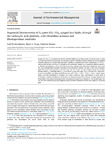Mostrar o rexistro simple do ítem
Sequential bioconversion of C1-gases (CO, CO2, syngas) into lipids, through the carboxylic acid platform, with Clostridium aceticum and Rhodosporidium toruloides
| dc.contributor.author | Robles-Iglesias, Raul | |
| dc.contributor.author | Veiga, María Carmen | |
| dc.contributor.author | Kennes, Christian | |
| dc.date.accessioned | 2024-08-09T10:02:26Z | |
| dc.date.available | 2024-08-09T10:02:26Z | |
| dc.date.issued | 2023 | |
| dc.identifier.citation | Robles-Iglesias, R., Veiga, M. C., & Kennes, C. (2023). Sequential bioconversion of C1-gases (CO, CO2, syngas) into lipids, through the carboxylic acid platform, with Clostridium aceticum and Rhodosporidium toruloides. Journal of Environmental Management, 347. https://doi.org/10.1016/J.JENVMAN.2023.119097 | es_ES |
| dc.identifier.uri | http://hdl.handle.net/2183/38510 | |
| dc.description | Financiado para publicación en acceso aberto: Universidade da Coruña/CISUG | es_ES |
| dc.description.abstract | [Abstract] Syngas (CO, CO2, H2) was effectively bioconverted into lipids in a two-stage process. In the first stage, C1-gases were bioconverted into acetic acid by the acetogenic species Clostridium aceticum through the Wood-Ljungdahl metabolic pathway in a stirred tank bioreactor, reaching a maximum acetic acid concentration of 11.5 g/L, with a production rate of 0.05 g/L·h. Throughout this experiment, samples were extracted at different periods, i.e., different concentrations, to be used in the second stage, aiming at the production of lipids from acetic acid. The yeast Rhodosporidium toruloides, inoculated in the acetogenic medium, was able to efficiently accumulate lipids from acetic acid generated in the first stage. The best results, in terms of lipid content, dry biomass, biomass yield (Y(X/S)) and lipid yield (Y(L/S)) were 39.5% g/g dry cell weight, 3 g/L, 0.35 and 0.107, respectively. In terms of abundance, the lipid profile followed the order: C18:1 > C16:0 > C18:2 > C18:0 > Others. Experiments were also performed to determine the toxicity exerted by high concentrations of acetic acid on R. toruloides, resulting in inhibition at initial acid concentrations around 18 g/L leading to a higher lag phase and being lethal to the yeast at initial acetic acid concentrations around 22 g/L and above. This research paves the way for a novel method of growing oleaginous yeasts to produce sustainable biofuels from syngas or C1-pollutant gases. | es_ES |
| dc.description.sponsorship | This study is supported by the Spanish Ministry of Science and Innovation and the European FEDER funding (PID2020-117805RB-I00). RR thanks that Ministry for funding his PhD contract (E-15-2019-0344365). The authors, who are members of the BIOENGIN group, are grateful to Xunta de Galicia for its funding to Competitive Reference Research Groups (ED431C 2021/55). Funding for open access charge is covered by Universidade da Coruña/CISUG. | es_ES |
| dc.description.sponsorship | Xunta de Galicia; ED431C 2021/55 | es_ES |
| dc.language.iso | eng | es_ES |
| dc.publisher | Elsevier | es_ES |
| dc.relation | info:eu-repo/grantAgreement/AEI/Plan Estatal de Investigación Científica y Técnica y de Innovación 2017-2020/PID2020-117805RB-I00/ES/PROCESOS DE BIOREFINERIA SOSTENIBLE PARA LA PRODUCCION DE BIOCOMBUSTIBLES, BIOPOLIMEROS Y OTROS BIOPRODUCTOS VIA ACIDOS CARBOXILICOS/ | es_ES |
| dc.relation.uri | https://doi.org/10.1016/J.JENVMAN.2023.119097 | es_ES |
| dc.rights | CC BY-NC-ND 4.0 Attribution-NonCommercial-NoDerivatives 4.0 International | es_ES |
| dc.rights.uri | http://creativecommons.org/licenses/by-nc-nd/3.0/es/ | * |
| dc.subject | Acetogenesis | es_ES |
| dc.subject | Fatty acid methyl ester | es_ES |
| dc.subject | Oleaginous yeas | es_ES |
| dc.subject | Biodiesel | es_ES |
| dc.subject | Greenhouse gases | es_ES |
| dc.title | Sequential bioconversion of C1-gases (CO, CO2, syngas) into lipids, through the carboxylic acid platform, with Clostridium aceticum and Rhodosporidium toruloides | es_ES |
| dc.type | info:eu-repo/semantics/article | es_ES |
| dc.rights.access | info:eu-repo/semantics/openAccess | es_ES |
| UDC.journalTitle | Journal of Environmental Management | es_ES |
| UDC.volume | 347 | es_ES |
| UDC.startPage | Article 119097 | es_ES |
| dc.identifier.doi | 10.1016/J.JENVMAN.2023.119097 |
Ficheiros no ítem
Este ítem aparece na(s) seguinte(s) colección(s)
-
GI-BIOENGIN- Artigos [106]






